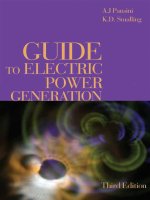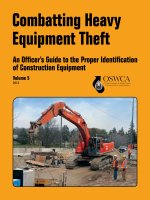- Trang chủ >>
- Đại cương >>
- Kinh tế vĩ mô
guide to electrical power distribution systems
Bạn đang xem bản rút gọn của tài liệu. Xem và tải ngay bản đầy đủ của tài liệu tại đây (4.8 MB, 276 trang )
TeAM
YYePG
Digitally signed by TeAM
YYePG
DN: cn=TeAM YYePG,
c=US, o=TeAM YYePG,
ou=TeAM YYePG,
email=
Reason: I attest to the
accuracy and integrity of
this document
Date: 2005.02.07 18:12:50
+08'00'
i
Guide to
Electrical Power
Distribution Systems
Sixth Edition
ii
Tree of Electricity
Transmission and Distribution
PDL: Primary distribution lines, ✭ indicates location of transformer stations.
iii
Guide to
Electrical Power
Distribution Systems
Sixth Edition
Anthony J. Pansini, EE, PE
Life Fellow IEEE, Sr. Member ASTM
THE FAIRMONT PRESS, INC.
iv
Library of Congress Cataloging-in-Publication Data
Pansini, Anthony J.
Guide to electrical power distribution systems/Anthony J. Pansini 6th ed.
p. cm.
Includes index.
ISBN: 0-88173-505-1 (print) — 0-88173-506-X (electronic)
1. Electric power distribution. 2. Electric power transmission. I. Title.
[TK3001.P284 2005]
621.319 dc22
2004056257
Guide to electrical power distribution systems, sixth edition/Anthony J. Pansini
©2005 by The Fairmont Press, Inc. All rights reserved. No part of this publication
may be reproduced or transmitted in any form or by any means, electronic or
mechanical, including photocopy, recording, or any information storage and
retrieval system, without permission in writing from the publisher.
Published by The Fairmont Press, Inc.
700 Indian Trail
Lilburn, GA 30047
tel: 770-925-9388; fax: 770-381-9865
Distributed by Marcel Dekker/CRC Press
2000 N.W. Corporate Blvd.
Boca Raton, FL 33431
tel: 800-272-7737
Printed in the United States of America
10 9 8 7 6 5 4 3 2 1
0-88173-505-1 (The Fairmont Press, Inc.)
0-8493-3666-X (Dekker/CRC Press)
While every effort is made to provide dependable information, the publisher,
authors, and editors cannot be held responsible for any errors or omissions.
v
To my superiors, associates,
colleagues, and subordinates,
from whom—along the way—
I learned much
This page intentionally left blank
vii
Contents
Preface ix
Chapter
1. The Transmission and Distribution System 1
2. Conductor Supports
3. Insulators and Conductors
4. Line Equipment
5. Overhead Construction
6. Underground Construction
7. Service Factors
8. Substations
9. Distribution Circuits, Cogeneration and Distributed Generation
10. Essentials of Electricity
Appendix A. Insulation: Porcelain vs. Polymer
Appendix B. Street Lighting, Constant Current Circuitry
Appendix C. The Grid Coordinate System,
Tying Maps to Computers
Appendix D. United States and Metric Relationships
Index
viii
Figure P-1. Simplified schematic diagram of transition from regulated
to deregulated supply systems.
ix
Preface to the
Sixth Edition
This edition continues the practice of updating its contents to re-
flect changes affecting electric distribution systems. It continues its origi-
nal role of providing information in a non or semi technical manner to
persons working on such systems enabling them to perform their duties
in an enlightened way. This contributes not only to a greater quality of
production, but more importantly, with greater safety to themselves and
the general public, the consumers they serve.
While the effects of deregulation have been more pronounced on
the generation and transmission components of the supply chain, it has
also had an impact on the distribution system with its cogeneration and
distributed generation features.
Improvement in materials and methods continue to contribute to
the economic and environmental betterment enjoyed by consumers.
Predominant among these include the gradual replacement of heavier
porcelain insulators with polymer (plastic) ones, the employment of
insulated bucket vehicles making climbing with the use of spikes a lost
art. Improvements in “solid” type insulation in cables, and more effi-
cient machinery for placing them underground. Thus narrowing the
economic differences between overhead and underground installations.
The distribution system is the most visible part of the supply chain,
and as such the most exposed to the critical observation of its users. It
is, in many cases, the largest investment, maintenance and operation
expense, and the object of interest to government, financial agencies, and
“watch dog” associations of concerned citizens. As such, the desirability
of knowing how and why it is so constituted becomes obvious.
Distribution systems have also been affected by deregulation, al-
though not in the same manner as transmission systems, Figure P-1
(opposite). Where additional transmission or generation was not avail-
able or too great an expense to supply some additional loads, Distrib-
uted Generation made its entry on Distribution Systems. Here, small
generating units usually powered by small gas turbines (although other
x
units such as wind powered, solar, fuel cells, etc. may be involved) are
connected to the system as are cogeneration units, both with possible
hazard to safety.
These notes were begun in the early 1940’s as classroom material,
part of a rapid training program for line personnel. The program was
highly successful, reflected in greater safety and production among
other benefits, and achieved national attention.
Once again, our thanks to our old friends, Ken Smalling and The
Fairmont Press for their help and support.
Anthony J. Pansini
Waco, Texas, 2004
The Transmission and Distribution System 1
1
Chapter 1
The Transmission and
Distribution System
INTRODUCTION
Like any other industry, the electric power system may be thought
of as consisting of three main divisions:
1. manufacture, production or generation, cogeneration,
2. delivery or transmission and distribution,
3. consumption.
The discussions in this book will be limited to the subject of electric
distribution.
POWER TRANSMISSION
Figures 1-1 and 1-2 show a typical transmission and distribution
system in both pictorial and block diagram forms. Although geographi-
cal difficulties, demand variances, and other reasons may make for mi-
nor differences in some transmission and distribution systems, the
voltages chosen here are pretty typical. This is what happens to electric-
ity between the generator and a home, office, store, or factory.
There are many definitions of transmission lines, distribution cir-
cuits, and substations specifying distinctions between them. However,
none of these definitions is universally applicable. To give some idea of
where one ends and the other begins: Transmission may be compared to
bulk delivery of a commodity from factory to regional depots;
subtransmission from the depot to central area warehouses; primary
distribution from area warehouse to local wholesale vendors; secondary
distribution from the vendors to local stores; services from store to con-
sumer.
2 Electrical Power Distribution Systems
Figure 1-1. Typical electrical supply from generator to customer show-
ing transformer applications and typical operating voltages.
The Transmission and Distribution System 3
Figure 1-2. Typical transmission and distribution system.
4 Electrical Power Distribution Systems
In the pictorial rendition, note that the generator produces
20,000 volts. This, however, is raised to 138,000 volts for the long
transmission journey. This power is conducted over 138,000-volt (138
kV) transmission lines to switching stations located in the important
load area served. These steel tower or wood frame lines, which con-
stitute the backbone of the transmission system, span fields and rivers
in direct cross country routes. When the power reaches the switching
stations, it is stepped down to 69,000 volts (69 kV) for transmission in
smaller quantities to the substations in the local load areas. (In some
cases it might be stepped down to 13,800 volts [13.8 kV] for direct
distribution to local areas.) Transmission circuits of such voltages usu-
ally consist of open wires on wood or steel poles and structures in
outlying zones (along highways, for example) where this type of con-
struction is practicable.
Other transmission-line installations can provide an interchange
of power between two or more utility companies to their mutual ad-
vantage. Sometimes, in more densely populated areas, portions of
these transmission lines may consist of high-voltage underground sys-
tems operating at 69,000, 138,000, 220,000, 345,000, 500,000, and
750,000 volts.
WATER-CURRENT ANALOGY
The flow of electric current may be visualized by comparing it with
the flow of water. Where water is made to flow in pipes, electric current
is conducted along wires.
To move a definite amount of water from one point to another in
a given amount of time, either a large-diameter pipe may be used and
a low pressure applied on the water to force it through, or a small-diam-
eter pipe may be used and a high pressure applied to the water to force
it through. While doing this it must be borne in mind that when higher
pressures are used, the pipes must have thicker walls to withstand that
pressure (see Figure 1-3).
The same rule applies to the transmission of electric current. In this
case, the diameter of the pipe corresponds to the diameter of the wire
and the thickness of the pipe walls corresponds to the thickness of the
insulation around the wire, as shown in Figure 1-4.
The Transmission and Distribution System 5
Figure 1-3. Comparison of water flow through different size pipes.
Figure 1-4. Comparison of current flow in different size wires.
THE DISTRIBUTION SYSTEM
At the substations, the incoming power is lowered in voltage for
distribution over the local area. Each substation feeds its local load area
by means of primary distribution feeders, some operating at 2400 volts and
others at 4160 volts and 13,800 volts or higher.
Ordinarily, primary feeders are one to five miles in length; in rural
sections where demands for electricity are relatively light and scattered,
they are sometimes as long as 10 or 12 miles. These circuits are usually
6 Electrical Power Distribution Systems
carried on poles; but in the more densely built-up sections, underground
conduits convey the cables, or the cable may be buried directly in the
ground.
Distribution transformers connect to the primary distribution lines.
These transformers step down the primary voltage from 2400 volts, 4160
volts, or 13,800 volts, as the case may be, to approximately 120 volts or
240 volts for distribution over secondary mains to the consumer’s ser-
vice (see Figure 1-5).
The lines which carry the energy at utilization voltage from the
transformer to consumer’s services are called secondary distribution
mains and may be found overhead or underground. In the case of trans-
formers supplying large amounts of electrical energy to individual con-
sumers, no secondary mains are required. Such consumers are railroads,
large stores, and factories. The service wires or cables are connected
directly to these transformers. Transformers may also serve a number of
Figure 1-5. Typical distribution system showing component parts.
The Transmission and Distribution System 7
consumers and secondary mains; they are located in practically every
street in the area served by utility companies.
Services and meters link the distribution system and the
consumer’s wiring. Energy is tapped from the secondary mains at the
nearest location and carried by the service wires to the consumer’s
building. As it passes on to operate the lights, motors, and various ap-
pliances supplied by the house wiring, it is measured by a highly accu-
rate device known as the watt-hour meter. The watt-hour meter
represents the cash register of the utility company (see Figure 1-6).
DETERMINING DISTRIBUTION VOLTAGES
It was pointed out earlier that low voltages require large conduc-
tors, and high voltages require smaller conductors. This was illustrated
with a water analogy. A small amount of pressure may be applied and
the water will flow through a large pipe, or more pressure may be ap-
plied and the water will flow through a slimmer pipe. This principle is
basic in considering the choice of a voltage (or pressure) for a distribu-
tion system.
There are two general ways of transmitting electric current-over-
head and underground. In both cases, the conductor may be copper or
Figure 1-6. Changes in voltage from generator to consumer. All along
the journey, voltage is helped down from transmission-line level to a
usable level by transformers.
8 Electrical Power Distribution Systems
aluminum, but the insulation in the first instance is usually air, except at
the supports (poles or towers) where it may be porcelain or glass. In
underground transmission, the conductor is usually insulated with rub-
ber, paper, oil, plastic, or other material.
In overhead construction, the cost of the copper or aluminum as
compared to the insulation is relatively high. Therefore, it is desirable
when transmitting large amounts of electric power, to resort to the
higher electrical pressures-or voltages, thereby necessitating slimmer,
less expensive conductors. Low voltages necessitate heavy conductors
which are bulky and expensive to install, as well as intrinsically expen-
sive.
However, there is a limit to how high the voltage may be made and
how thin the conductors. In overhead construction there is the problem
of support-poles or towers. If a conductor is made too thin, it will not be
able to support itself mechanically. Then the cost of additional supports
and pole insulators becomes inordinately high. Underground construc-
tion faces the same economic limitation. In this case, the expense is in-
sulation. Underground a cable must be thoroughly insulated and
sheathed from corrosion. The higher the voltage, the more insulation is
necessary, and the bigger the conductor, the more sheathing is necessary
(see Figure 1-7).
Determining distribution voltages is a matter which requires care-
ful studies. Experts work out the system three or four different ways. For
instance, they figure all the expenses involved in a 4000-volt (4 kV), in
a 34,500-volt (34.5 kV), or a 13,000-volt (13 kV) system.
The approximate costs of necessary equipment, insulators,
switches, and so on, and their maintenance and operation must be care-
fully evaluated. The future with its possibilities of increased demand
must also be taken into consideration.
Safety is the most important factor. The National Electric Safety
Code includes many limitations on a utility company’s choice of voltage.
Some municipal areas also set up their own standards.
The utility company must weigh many factors before determining
a voltage for distribution.
It was mentioned that safety is the most important factor in deter-
mining voltages for distributing electricity. Here’s why! Consider what
happens when a water pipe carrying water at high pressure suddenly
bursts (see Figure 1-8). The consequences may be fatal and damage con-
siderable. The same is true of electrical conductors. Safeguarding the life
The Transmission and Distribution System 9
Figure 1-7. Practical economics affect the size of a transmission line.
10 Electrical Power Distribution Systems
and limb of the public as well as workers is an important responsibility
of the utility company.
Table 1-1 shows typical transmission and distribution system volt-
ages in use at the present time.
Figure 1-8. The danger of high voltages. (a) Pipe rupturing-water spills
over adjacent areas; (b) Rupture of cable insulation causes arcing to
other wires-sometimes causing flame.
Table 1-1. Typical Voltages in Use
————————————————————————————————
Main Sub Primary Distribution
Transmission Transmission Distribution Secondary
————————————————————————————————
69,000 V 13,800 V 2,400 V 120 V
138,000 V 23,000 V 4,160 V 120/240 V
220,000 V 34,500 V 13,800 V 240 V
345,000 V 69,000 V 23,000 V 277/480 V
500,000 V 138,000 V 34,500 V 480 V
750,000 V
————————————————————————————————
The Transmission and Distribution System 11
REVIEW QUESTIONS
1. What are the three main divisions of an electric power system?
2. Distinguish between transmission and distribution.
3. What is the function of a substation?
4. What are the links between the utility company’s facilities and the
consumer’s premises?
5. What are the two ways of distributing electric energy?
6. Compare the flow of water in a pipe with that of electric current
in a wire. What is the relationship between water pressure and
voltage? Pipe diameter and conductor diameter? Thickness of
pipe and insulation?
7. What is electrical pressure called?
8. What are the two most important factors to be considered in
determining a distribution voltage?
9. What changes in the functions of generation and transmission are
due to deregulation?
10. What changes in distribution are associated with deregulation?
12 Electrical Power Distribution Systems
This page intentionally left blank
Conductor Supports 13
13
Chapter 2
Conductor Supports
SUPPORTS FOR OVERHEAD CONSTRUCTION
Conductors need supports to get from one place to another. Sup-
ports may be towers, poles, or other structures. The latter may be made
of steel, concrete, or wood. The choice of a type of support depends on
the terrain to be crossed and the size of conductors and equipment to be
carried. Availability and economy, as well as atmospheric elements de-
termine the choice of material.
Usually steel poles and towers (Figure 2-1) are used for transmis-
sion lines and wood (Figure 2-2) and concrete poles for distribution cir-
cuits. However, this distinction doesn’t always hold true. To meet the
needs of a particular circumstance, wood or concrete poles can be used
to carry transmission lines; and in some instances a steel tower might be
necessary for a distribution circuit.
In general, steel towers are used where exceptional strength and
reliability are required. Given proper care, a steel tower is good indefi-
nitely.
Steel can also be used for poles. Although they are comparatively
expensive, considerations of strength for large spans, crossing railroads
or rivers, for example, make wood undesirable and steel poles, complete
with steel crossarms are necessary.
In the United States, overhead construction more often consists of
wood poles with the conductor wires attached to insulators supported
on wood crossarms. Although steel and concrete poles are also used,
wood has two desirable advantages: initial economy and natural insulat-
ing qualities.
The choice of wood for poles depends on what is available in the
particular section of the country. For example, in the central United
States, poles of northern white cedar are most apt to be found because
it is easily available in Minnesota, Wisconsin, and Michigan. Because of
the preponderance of western red cedar in Washington, Oregon, and









